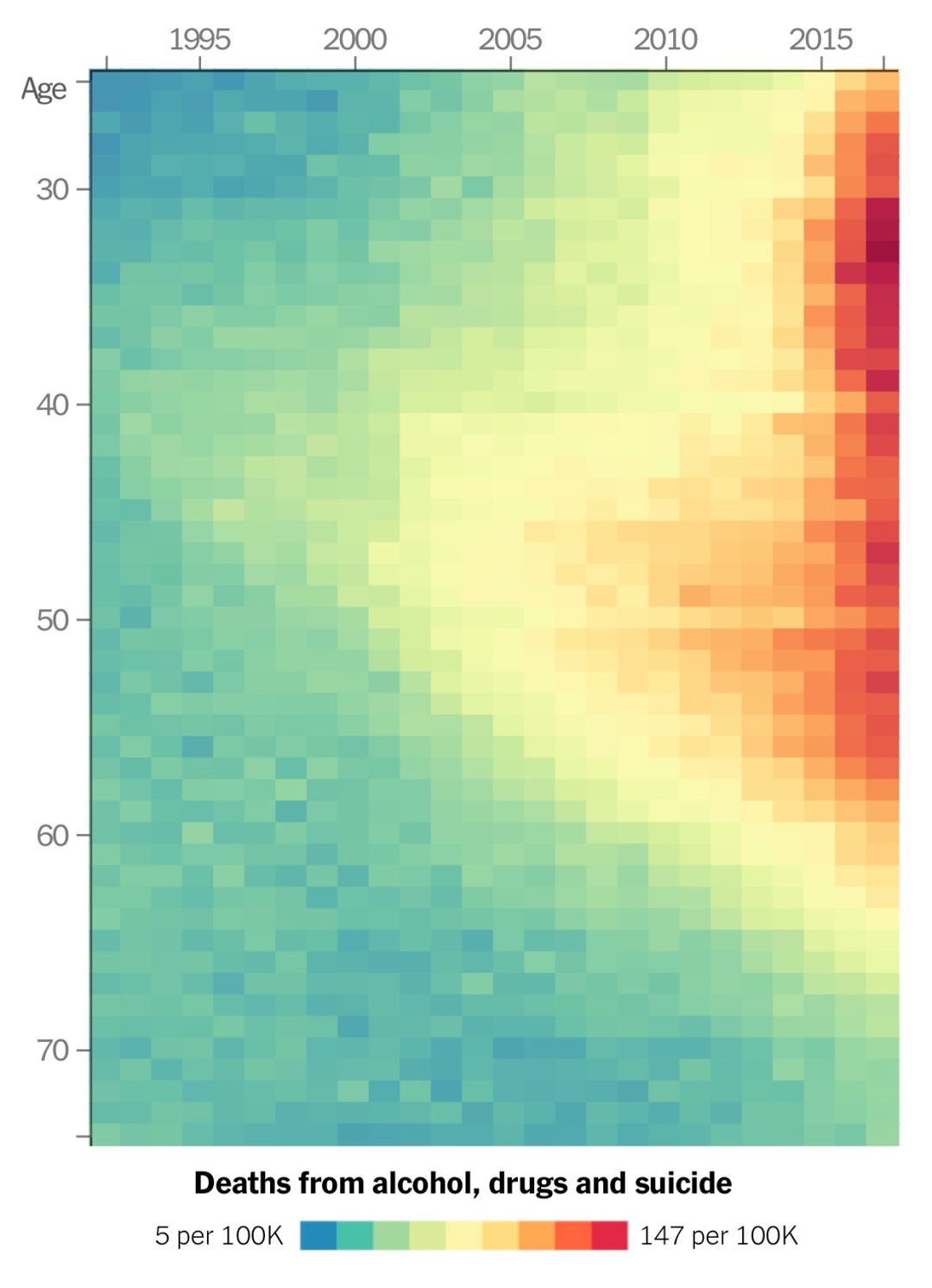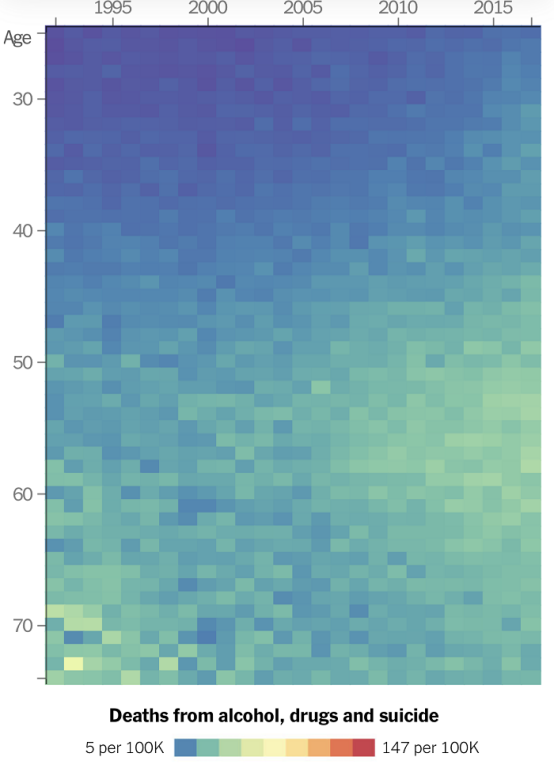Author: Pei Yiwen data support: macro Group of Yuanchuan Research Institute
In 2015, Princeton University professor Angus Deaton and his wife Anne Case published a groundbreaking paper on middle-aged mortality in the United States after winning the Nobel Prize in economics.
They found that the proportion of suicides among middle-aged whites between the ages of 45 and 54 in the United States has continued to rise sharply since the 1990s. Some drink to death, some go crazy on drugs, and some simply commit suicide.
 The two scientists called it a "death of despair" and pointed out that it was not only a public health crisis caused by an overdose, but also an economic crisis:Wage growth in the United States is slow, the burden of health care is heavy, and the working class is suffering more and more economic insecurity.
The two scientists called it a "death of despair" and pointed out that it was not only a public health crisis caused by an overdose, but also an economic crisis:Wage growth in the United States is slow, the burden of health care is heavy, and the working class is suffering more and more economic insecurity.
In a new study, Deaton and Case found that in terms of "death of despair", there are frequent differences between educated and uneducated. Also among middle-aged whites, those who finished four years of college were more likely to marry and were less likely to be obese and addicted to drugs and alcohol.
It can be said that life is desperate, and people who do not go to college are even more desperate. However, whites who do not have a four-year college degree make up as much as 38 per cent of the US workforce.
The death of despair continues, and the New York Times publishes an article about the latest findings of two scientists, showing you some thoughts about American capitalism:
When economists Anne Case and Angus Deaton first published their study of death of despair five years ago, they focused on middle-aged whites.It is bizarre that too many white working-class people in their 40s and 50s die of suicide, alcohol and drug abuse, so the total death rate in this age group only goes up.
But as Case and Deaton continue to mine data, they find that this grim trend is not just for middle-aged whites. Among people without a four-year college degree, the number of "desperate deaths" is also on the rise.
Among adult whites without college education, only a few people died in the early 1990s as a result of drug overdose, alcohol abuse or suicide, and the mortality rate of the young was lower than that of the elderly. However, in the past 30 years, the number of "dead" people in this group has skyrocketed, especially those under the age of 50.

However, the death rate increases much more slowly among people with college degrees. From Huang-kou children to octogenarian people, those with degrees live better, but it is normal for young people to have lower mortality rates.

Case and Deaton, economists at Princeton University, try to explain this in their new book death of despair and the Future of Capitalism. Their answer is:Compared with other high-income countries, the life of the working class in the United States is worse.
"European countries face the same technological changes as we do, but no one has solved themselves with guns, drugs or alcohol," Case said. There is something unique about the way the United States deals with it. "

Compared with France, Germany, Japan and other countriesSocial inequality in the United States has intensified, and the income of the middle class has stagnated.. Big companies have a growing market share, trade unions are useless, and workers' bargaining power is no longer available. Outsourcing has become the norm, so executives often see low-paid workers as expenses rather than colleagues.
In addition, the United States has so farThe most expensive health care system in the world. It is a tax on workers and consumes resources that could have been used for schools, day care, roads, public transport, and so on. And despite spending a lot of money, the American health care system has failed to guarantee the health of many people.
The two economists initially focused on non-Hispanic whites because their mortality rates seemed to be the worst. For example, after 2000, the death rate caused by suicide, alcohol and drug abuse of whites was higher than that of blacks. But the black working class did not seize this great opportunity to grow, and the number of people who died in despair has greatly increased in the past few years. The overall life expectancy of whites still lags blacks, as well as in terms of income and wealth.
Many of the problems that plague the working class span race, and Case and Deaton stress that these are not just financial issues. The lives of many low-and middle-income Americans lack status and meaning. They do not know how long they will work next week, and they are often not regular employees of the company, so they are precarious, like a drifting duckweed, with no sense of belonging and honor to the enterprise.
Deaton, a Nobel laureate in economics, said: "many people used to associate the meaning of life with what companies do. "that's what miners and factory workers do. Warehouse workers who are paid by manpower dispatch companies rarely have such an emotional connection.
As Case and Deaton said,The result of this development is a "disconnect", that is, a huge gap in daily life between whites without a college degree and whites with a college degree.. For example, people with degrees are more likely to marry and go to church more frequently.


Surveys show that more and more American working class are finding it difficult to do basic things, such as climbing stairs or participating in social activities, partly because of physical and mental health problems. People without a degree are more likely to have chronic pain, drink more, and are less happy.



In addition to suicide, alcohol and drug overdose, a number of other causes of death have also increased among Americans without a college degree, with obesity, alcohol and drug use being the most serious causes of heart disease.
The comprehensive conclusion is that there is a difference in life expectancy between white college graduates and non-college graduates.The overall mortality rate for whites between the ages of 45 and 54 has remained generally stable over the past 25 years. However, this overall value masks the fact that the death rate of non-college graduates has risen sharply while that of graduates has fallen sharply.
What are we going to do? Many solutions are obviously difficult to implement. Case and Deaton argue that the health care system should be overhauled so that health is more important than wealth. This does not necessarily mean compulsory health insurance, they added.
In addition, the federal government should prevent large companies from maximizing profits at the expense of workers by enforcing antitrust laws and encouraging the establishment of new trade unions. Governments at all levels should help more people obtain university degrees, including four-year degrees (such as bachelor's degrees) and vocational degrees.
Other economic studies have found that a college degree is more than just a marker. Students who go to college and graduate are better off than other students who don't get the same opportunities. College graduates are more likely to find jobs, partners and earn more money, are more satisfied with their lives, and are healthier and live longer.These findings suggest that the university itself-whether learning in the classroom or the experience of successful admission to a university-can bring long-term benefits.
Case and Deaton's book does not focus on education, but education is the background of their findings. "the difference between educated and non-educated is always repeated," Deaton said. "

Original text: How Working-Class Life Is Killing Americans, in Charts.David Leonhardt. Stuart A. Thompson. NYTimes. March 6, 2020
Edit / Ray

 两位科学家将这称作「绝望之死」,并指出这不仅是一场药物过量的公共健康危机,更是一场经济危机:美国工资增长缓慢,而医保负担严重,工人阶级在经济上承受着越来越多的不安全感。
两位科学家将这称作「绝望之死」,并指出这不仅是一场药物过量的公共健康危机,更是一场经济危机:美国工资增长缓慢,而医保负担严重,工人阶级在经济上承受着越来越多的不安全感。